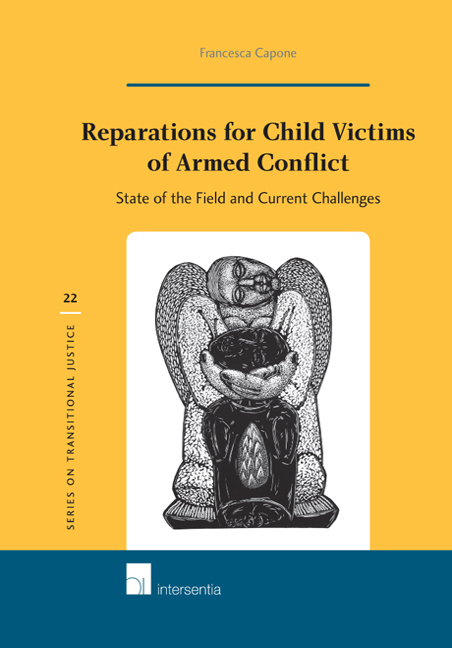Book contents
- Frontmatter
- Dedication
- Foreword
- About the Author
- Acknowledgements
- Contents
- Table of Cases
- Table of International Instruments
- List of Abbreviations
- Chapter 1 Setting the Scene
- PART I THE NORMATIVE AND THEORETICAL FRAMEWORK
- Chapter 2 Children as Victims of Armed Conflict
- Chapter 3 The Right to Reparation in International Law: Developments, Shortcomings and their Relevance to Child Victims of Armed Conflict.
- Chapter 4 Forms and Scope of Reparations for Child Victims of Armed Conflict
- PART II CURRENT APPLICATION OF THE PRINCIPLES AND NORMS
- Bibliography
- Index
Chapter 2 - Children as Victims of Armed Conflict
from PART I - THE NORMATIVE AND THEORETICAL FRAMEWORK
Published online by Cambridge University Press: 29 September 2018
- Frontmatter
- Dedication
- Foreword
- About the Author
- Acknowledgements
- Contents
- Table of Cases
- Table of International Instruments
- List of Abbreviations
- Chapter 1 Setting the Scene
- PART I THE NORMATIVE AND THEORETICAL FRAMEWORK
- Chapter 2 Children as Victims of Armed Conflict
- Chapter 3 The Right to Reparation in International Law: Developments, Shortcomings and their Relevance to Child Victims of Armed Conflict.
- Chapter 4 Forms and Scope of Reparations for Child Victims of Armed Conflict
- PART II CURRENT APPLICATION OF THE PRINCIPLES AND NORMS
- Bibliography
- Index
Summary
INTRODUCTION
During its forty-eighThsession, the General Assembly adopted Resolution 48/157, entitled ‘Protection of Children Affected by Armed Conflicts’, in which it requested the Secretary-General to appoint an expert to undertake a comprehensive study wiThthe support of the Centre for Human Rights and UNICEF. The expert, Ms Gra ç a Machel, was asked to make recommendations in five areas: the participation of children in armed conflict; the reinforcement of preventive measures; the relevance and adequacy of existing standards; the measures required to improve the protection of children affected by armed conflict; and the actions needed to promote the physical and psychological recovery and social reintegration of children affected by armed conflict. The Machel' study underlined wiThdeep concern how ‘new’ war tactics had evolved, resulting in civilians, including children, increasingly becoming the targets of violence and the victims of atrocities. This trend continues as armed conflicts nowadays have an even more horrific impact on children, and on civilians generally. In today's wars, the strategies adopted by armed groups' seek to bring the battle more immediately, more systematically, and more massively to the core of the civilian population’, and into the lives of millions of children. As a result, the notion of armed conflict itself has become more blurred and less easily defined. The Stockholm International Peace Research Institute has stressed the fact that armed conflicts are moving towards ‘further fragmentation of violence’. According to this analysis, such trend has been accompanied by the diversification of armed groups and the further erosion of the boundaries between different forms of violence. Consequently much of this ‘fragmented’ violence is difficult to assess and categorise.
The alarming situation of children in armed conflict has become a thematic issue on the UN agenda aft er the submission of Machel's ground-breaking report. As a result more initiatives and resolutions have been adopted and implemented.
- Type
- Chapter
- Information
- Reparations for Child Victims of Armed ConflictState of the Field and Current Challenges, pp. 21 - 68Publisher: IntersentiaPrint publication year: 2017



